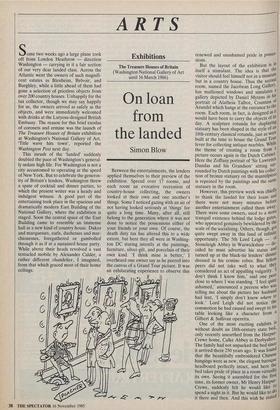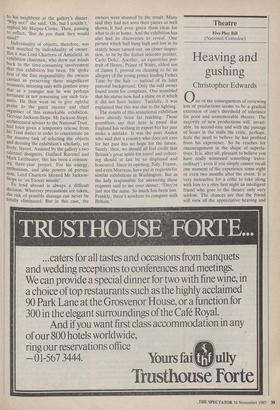ARTS
Some two weeks ago a large plane took off from London Heathrow — direction Washington — carrying in it a fair section of our very dear landed class. Across the Atlantic went the owners of such magnifi- cent estates as Blenheim, Belvoir, and Burghley, while a little ahead of them had gone a selection of priceless objects from over 200 country houses. Unhappily for the tax collector, though we may say happily for us, the owners arrived as safely as the objects, and were immediately welcomed with drinks at the Lutyens-designed British Embassy. The reason for this brief exodus of coronets and ermine was the launch of The Treasure Houses of Britain exhibition at Washington's National Gallery of Art. `Title wave hits town', reported the Washington Post next day.
This inrush of the 'landed' suddenly doubled the pace of Washington's general- ly sedate high life. For Washington is not a city accustomed to operating at the speed of New York. But to celebrate the generos- ity of Britain's lenders, Washington threw a spate of cocktail and dinner parties, to which the present writer was a heady and indulgent witness. A good part of the entertaining took place in the spacious and dramatically modern East Building of the National Gallery, where the exhibition is staged. Soon the central space of the East Building came to resemble an immense hall in a new kind of country house. Dukes and marquesses, earls, duchesses and mar- chionesses, foregathered or gambolled through it as if at a sustained house party. While above their heads revolved a vast tentacled mobile by Alexander Calder, a rather different chandelier, I imagined, from that which graced most of their home ceilings.
Exhibitions
The Treasure Houses of Britain (Washington National Gallery of Art until 16 March 1986)
On loan from the landed
Simon Blow
Between the entertainments, the lenders applied themselves to their preview of the exhibition. Spread over 17 rooms, and each room an evocative recreation of country-house collecting, the owners looked at their own and one another's things. Some I noticed gazing With an air of not having looked seriously at 'things' for quite a long time. Many, after all, still belong to the generation where it was not done to notice the possessions either of your friends or your own. Of course, the death duty tax has altered this to a wide extent, but here they all were in Washing- ton DC staring intently at the paintings, furniture, silver-gilt, and porcelain of their own kind. 'I think mine is better,' I overheard one owner say as he peered into the canvas of a Grand Tour picture. It was an exhilarating experience to observe this renewed and unashamed pride in posses- sions.
But the layout of the exhibition is in itself a stimulant. The idea is that the visitor should feel himself not in a museum but in a country house. Thus the second room, named the Jacobean Long GallerY, has mullioned windows and simulates a gallery depicted by Daniel Mytens in his portrait of Alatheia Talbot, Countess of Arundel which hangs at the entrance to the room. Each room, in fact, is designed as it would have been to carry the objects of i
. ts
day. A sculpture rotunda for displaying statuary has been shaped in the style of all 18th-century classical rotunda, just as were built at the time to house the Grand Tour fever for collecting antique marbles. While the theme of creating a room from a picture occurs again in the Dutch Cabinet. Here the Zoffany portrait of 'Sir Lawrence Dundas and his Grandson' sitting sur" rounded by Dutch paintings with his collec- tion of bronze statuary on the mantelpiece is repeated by the paintings and the sane statuary in the room. However, this preview week was chietlY to thank the landed for their loans and there were not many minutes before another entertainment called them avvaY. There were some owners, used to a more tranquil existence behind the lodge gates, who appeared genuinely bewildered by the scale of the socialising. Others, though, got quite swept away in this land of infinite opportunity. The 5th Lord Leigh — of Stoneleigh Abbey in Warwickshire — de; cided he must advertise his status and turned up at the black-tie lenders' dinner dressed in his ermine robes. But fellow peers did not take well to what the considered an act of appalling vulgarity. I don't think I know him,' said one Peer close to where I was standing. 'I feel quite ashamed,' announced a peeress who Was telling me about the picture her husband had lent, 'I simply don't know where to look.' Lord Leigh did not notice the commotion he had caused and swept to his table looking like a character from a Gilbert & Sullivan operetta. One of the most exciting exhibits is without doubt an 18th-century state bed, only recently unearthed from the HarPnr" Crewe home, Calke Abbey in Derbyshire' The family had not unpacked the bed since, it arrived there 250 years ago. It was found that the beautifully embroidered Chinese hangings were as new, the elegant baroque headboard perfectly intact, and here the bed takes pride of place in a room virtually its own. Seeing it assembled for the first time, its former owner, Mr Henry Harpur" Crewe, suddenly felt he would like to spend a night in it. But he would like to do it there and then. And this wish he stated
to his neighbour at the gallery's dinner. 'Why not?' she said. 'Oh, but I couldn't,' replied Mr Harpur-Crewe. Then, pausing to reflect, 'But do you think they would mind?'
Individuality of objects, therefore, was well matched by individuality of owner. But it was Lord Charteris of Amisfield, as exhibition chairman, who drew our minds back to the time-consuming involvement that this exhibition has been. He spoke first of the fine responsibility the owners carried in preserving these magnificent treasures, stressing only with gentlest irony that as a younger son he was perhaps . fortunate in not possessing any such trea- sures. He then went on to give rightful praise to the guest curator and chief organiser of this remarkable exhibition, Gervase Jackson-Stops. Mr Jackson-Stops, architectural adviser to the National Trust, had been given a temporary release from his Trust duties in order to concentrate on the massive task of selecting the objects and devising the exhibition's scholarly, yet lively, layout. Assisted by the gallery's two talented designers, Gaillard Ravenel and Mark Leithauser, this has been a consum- ing three-year project. For his energy, enthusiasm, and able powers of persua- sion, Lord Charteris likened Mr Jackson- Stops to 'an Exocet missile'.
To lend abroad is always a difficult decision. Whatever precautions are taken, the risk of possible damage can never be totally eliminated. But in this case, the owners were stunned by the result. Many said they had not seen their pieces so well shown; it had even given them ideas for what to do at home. And the exhibition has also had its discoveries to reveal. One picture which had hung high and lost in its stately home turned out, on closer inspec- tion, to be by the Italian seicento painter, Carlo Dolci. Another, an equestrian por- trait of Henry, Prince of Wales, eldest son of James I, proved on cleaning to be an allegory of the young prince leading Father Time by the hair — instead of its later pastoral background. Only the odd owner found room for complaint. One mumbled that his statue now had a shine on it which it did not have before. Tactfully, it was explained that this was due to the lighting. The results of this sensational exhibition have already been far reaching. Those grumblers say that here is proof that England has nothing to export but her past make a mistake. It was the poet Auden who said jhat a country who does not care for her past has no hope for the future. Surely, then, we should all feel credit that Britain's great spirit for travel and collect- ing should at last be so displayed and honoured. Since its opening, Italy, France, and even Morocco, have put in requests for similar exhibitions in Washington. But as the lady responsible for answering these requests said to me over dinner, 'They're just not the same. So much has been lost. Frankly, there's nowhere to compare with Britain.'



































































 Previous page
Previous page